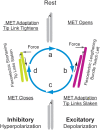Hair cell bundles: flexoelectric motors of the inner ear
- PMID: 19384413
- PMCID: PMC2668172
- DOI: 10.1371/journal.pone.0005201
Hair cell bundles: flexoelectric motors of the inner ear
Abstract
Microvilli (stereocilia) projecting from the apex of hair cells in the inner ear are actively motile structures that feed energy into the vibration of the inner ear and enhance sensitivity to sound. The biophysical mechanism underlying the hair bundle motor is unknown. In this study, we examined a membrane flexoelectric origin for active movements in stereocilia and conclude that it is likely to be an important contributor to mechanical power output by hair bundles. We formulated a realistic biophysical model of stereocilia incorporating stereocilia dimensions, the known flexoelectric coefficient of lipid membranes, mechanical compliance, and fluid drag. Electrical power enters the stereocilia through displacement sensitive ion channels and, due to the small diameter of stereocilia, is converted to useful mechanical power output by flexoelectricity. This motor augments molecular motors associated with the mechanosensitive apparatus itself that have been described previously. The model reveals stereocilia to be highly efficient and fast flexoelectric motors that capture the energy in the extracellular electro-chemical potential of the inner ear to generate mechanical power output. The power analysis provides an explanation for the correlation between stereocilia height and the tonotopic organization of hearing organs. Further, results suggest that flexoelectricity may be essential to the exquisite sensitivity and frequency selectivity of non-mammalian hearing organs at high auditory frequencies, and may contribute to the "cochlear amplifier" in mammals.
Conflict of interest statement
Figures

 ) and increase in height (
) and increase in height ( ) under constant volume. Changes in length are accompanied by transverse motion due to the staircase gradient in stereocilia lengths and diagonal tip links. Deflections are resisted by actin stiffness and polymerization at the tip, the angular stiffness at the base, and fluid drag in the axial and transverse directions.
) under constant volume. Changes in length are accompanied by transverse motion due to the staircase gradient in stereocilia lengths and diagonal tip links. Deflections are resisted by actin stiffness and polymerization at the tip, the angular stiffness at the base, and fluid drag in the axial and transverse directions.

 , *) increasing as the stereocilia becomes shorter (3 lengths shown). Efficiencies are predicted to be higher for axial motion (dashed curves,
, *) increasing as the stereocilia becomes shorter (3 lengths shown). Efficiencies are predicted to be higher for axial motion (dashed curves,  , **) vs. transverse motion (solid curves, *). c) Power output is also predicted to be tuned with peak power occurring at a specific frequency (solid curves,
, **) vs. transverse motion (solid curves, *). c) Power output is also predicted to be tuned with peak power occurring at a specific frequency (solid curves,  , ***). Tuning is reduced if axial length changes are not coupled to cause transverse bundle motion (dashed curves).
, ***). Tuning is reduced if axial length changes are not coupled to cause transverse bundle motion (dashed curves).
References
-
- Mulroy MJ, Williams RS. Auditory stereocilia in the alligator lizard. Hear Res. 1987;25:11–21. - PubMed
-
- Garfinkle TJ, Saunders JC. Morphology of inner hair cell stereocilia in C57BL/6J mice as studied by scanning electron microscopy. Otolaryngol Head Neck Surg. 1983;91:421–426. - PubMed
-
- Hackney CM, Fettiplace R, Furness DN Department of CNeuroscience KUSUK. The functional morphology of stereociliary bundles on turtle cochlear hair cells. Hearing research. 1993;69(1–2):163–175. - PubMed
-
- Petrov AG. Flexoelectric model for active transport. New York: Plenum Press; 1975. pp. 111–125.
-
- Petrov AG. Flexoelectricity of model and living membranes. Biochim Biophys Acta. 2002;1561:1–25. - PubMed
Publication types
MeSH terms
Grants and funding
LinkOut - more resources
Full Text Sources
Miscellaneous

